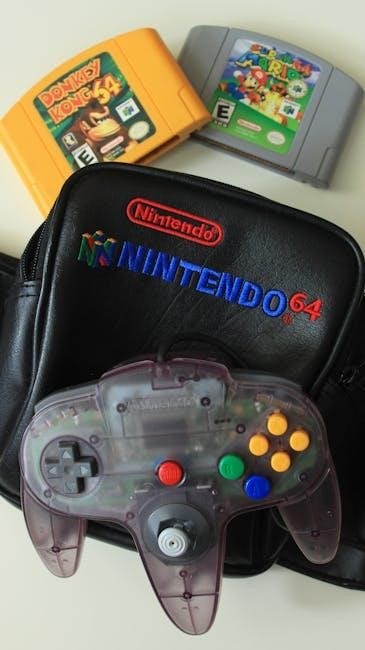Super Mario 64 is a groundbreaking 3D platformer released in 1996 for the Nintendo 64. Players control Mario as he rescues Princess Peach from Bowser, utilizing the innovative N64 controller. As a launch title, it showcased the console’s capabilities, revolutionizing 3D gaming with its immersive worlds and precise controls.

Controls and Gameplay Mechanics
Super Mario 64 introduces intuitive controls using the N64’s analog stick for 3D movement. Players can run, jump, and swim, while the camera system enhances exploration and combat, offering precise gameplay mechanics.
2.1 Basic Controls
Super Mario 64 introduces intuitive controls designed for the Nintendo 64 controller. Players use the analog stick for precise 3D movement, while the A button handles jumping and interactions; The B button is for punches and kicks, and the C buttons provide camera controls and special moves. Holding the controller as shown in the manual allows easy access to all buttons. The left thumb operates the Control Stick, enabling Mario to run, walk, or swim. The right thumb can press A, B, or C buttons for actions like jumping or attacking. This setup ensures fluid gameplay and easy navigation of the 3D environment. The manual emphasizes proper hand positioning for optimal control, making it essential for mastering Mario’s movements and interactions in the game world.
2.2 Camera Controls
Camera controls in Super Mario 64 are managed using the C Buttons on the Nintendo 64 controller. The C-Up button switches to a first-person view, while C-Down returns to Mario’s perspective. Players can adjust the camera angle using the analog stick, allowing precise control over the viewing direction. The manual highlights the importance of camera manipulation for navigating complex 3D environments and solving puzzles. Additionally, the camera can be locked onto specific points or enemies, aiding in targeting and exploration. Proper use of these controls enhances gameplay, enabling players to fully utilize the immersive 3D world. The manual emphasizes mastering camera techniques to optimize gameplay and discover hidden secrets effectively.
2.3 Advanced Techniques
Advanced techniques in Super Mario 64 allow players to exploit movement mechanics for greater control and precision. The Backwards Long Jump enables Mario to cover large distances by jumping backward with precise timing. The Side Somersault is another advanced move, performed by pressing the attack button while airborne, useful for dodging enemies or reaching hidden areas. Players can also utilize the “Crouch-Slide” technique to maintain speed while descending slopes. Additionally, the “Infinite Jump” glitch allows Mario to bounce indefinitely on certain surfaces, aiding in exploration and speedrunning. Mastering these techniques requires practice and understanding of the game’s physics, as detailed in the manual, making them essential for completing challenging levels and discovering hidden secrets effectively.

Power-Ups and Items
Super Mario 64 features various power-ups and items that enhance Mario’s abilities, such as the Super Mushroom, Fire Flower, and Star. These items provide unique powers like size increases, fireball attacks, and temporary invincibility, aiding Mario in overcoming challenges and defeating enemies. The manual details how to use these items effectively, ensuring players can maximize their gameplay experience and progress through the game’s diverse levels and secrets.
3.1 Types of Power-Ups
Super Mario 64 introduces a variety of power-ups that enhance Mario’s abilities. The Super Mushroom enlarges Mario, allowing him to break certain blocks and withstand one extra hit. The Fire Flower grants Mario the ability to throw fireballs, defeating enemies and igniting flammable objects. The Super Star makes Mario invincible for a short time, enabling him to defeat any enemy and withstand hazards. Additionally, the Koopa Shell lets Mario throw shells at enemies, while the Wing Cap allows temporary flight. Each power-up is strategically placed to aid in exploration and combat, as detailed in the manual.
3.2 Strategies for Using Power-Ups
Effective use of power-ups in Super Mario 64 is key to progressing through the game. The Super Mushroom should be used to access higher platforms or break hidden blocks. The Fire Flower is ideal for defeating tough enemies like Bulldogs or King Whomp, while the Super Star should be reserved for dangerous areas to ensure survival. The Wing Cap is perfect for reaching distant platforms or avoiding obstacles, and the Koopa Shell can be used to defeat enemies from a distance or activate switches. By strategically employing these power-ups, players can overcome challenges and uncover hidden secrets, as outlined in the manual.

Level Guides and Secrets
Super Mario 64’s manual provides detailed level guides and reveals hidden secrets, such as secret stars, hidden areas, and exclusive paths. It outlines strategies for navigating complex worlds, ensuring players discover all collectibles and unlockables, enhancing the overall gaming experience.
4.1 Overview of Different Worlds
Super Mario 64 features diverse and immersive worlds, each with unique themes, challenges, and secrets. The manual highlights key areas like Bob-omb Battlefield, Whomp’s Fortress, and Jolly Roger Bay, detailing their layouts and hidden collectibles. Players explore vast environments, from lush meadows to underwater realms, discovering secret stars and power-ups. Each world introduces new mechanics, such as riding Yoshi or navigating treacherous terrain, ensuring varied gameplay. The manual provides tips on optimizing exploration, revealing hidden paths, and overcoming obstacles. With its richly designed worlds, the game encourages creativity and thorough investigation, making every level a fresh adventure filled with surprises and rewards.
4.2 Hidden Secrets and Easter Eggs
Super Mario 64 is renowned for its abundance of hidden secrets and clever easter eggs, adding depth to its gameplay. The manual hints at the existence of secret stars in levels like “Dire, Dire Docks” and the hidden “The Missing Stars” level. Players can discover easter eggs such as the Yoshi egg on the castle roof or the backwards long jump trick. The game also features hidden areas, like the door requiring 8 stars to unlock, showcasing its intricate design. These secrets encourage exploration and reward players with unique experiences, making the game a timeless classic filled with surprises.
4.3 Finding Hidden Stars
Super Mario 64 contains 120 hidden Power Stars across various levels, each requiring unique strategies to collect. The manual guides players to explore meticulously, as stars are often concealed in challenging locations or tied to specific puzzles. For instance, “Bob-omb Battlefield” hides a star atop a tall mountain, while “Whomp’s Fortress” requires precise jumps to reach one. Players must also solve mini-games or defeat bosses to unlock certain stars. Collecting all 120 stars grants access to the final level, emphasizing the importance of thorough exploration and skill. The manual’s tips on using Mario’s abilities, like the backflip or long jump, are essential for locating these elusive stars, making the journey as rewarding as the destination.
4.4 Mini-games and Side Quests
Super Mario 64 offers a variety of mini-games and side quests that add depth to gameplay. These include challenges like racing a horse in “Bob-omb Battlefield” or solving puzzles in the Deku Tree maze. Players can also participate in a chess-like game in “Wet-Dry World” or test their jumping skills in the “Cool, Cool Mountain” sled race. The manual highlights these optional activities, encouraging exploration beyond the main objectives. Completing these mini-games often rewards players with Power Stars or unique items, enhancing the game’s replayability. These side quests not only provide fun diversions but also showcase Mario’s abilities in creative scenarios, making them a delightful addition to the adventure.

The Official Manual
The official Super Mario 64 manual is a 32-page guide detailing gameplay mechanics, controls, Power-Ups, and tips. It features colorful graphics and step-by-step instructions, ensuring players maximize their experience. Essential for understanding the game’s intricacies, the manual is both a practical resource and a cherished collectible.
5.1 Contents of the Manual
The official Super Mario 64 manual provides a comprehensive guide to the game, covering essential topics for players. It begins with instructions on how to hold the Nintendo 64 controller, emphasizing comfort and accessibility for optimal gameplay. The manual details basic controls, such as moving Mario with the Control Stick and using buttons for jumping and camera adjustments. It also explains gameplay mechanics, like collecting Power Stars, navigating levels, and interacting with objects. Tips for using Power-Ups and strategies for defeating enemies are included, along with information on saving progress and accessing special features. Diagrams and screenshots illustrate complex moves and level layouts, ensuring players can master the game’s challenges. The manual concludes with troubleshooting tips and warranty details, making it an invaluable resource for both new and experienced players.
5.2 Significance of the Manual
The Super Mario 64 manual holds significant value as a nostalgic artifact and a practical guide. Its detailed instructions helped players adapt to the revolutionary 3D gameplay and the N64 controller, making it essential for understanding the game’s mechanics. The manual also served as a gateway to the Mushroom Kingdom, offering insights into the game’s world and objectives. Its clear layout and concise information ensured players could navigate the immersive levels and unlock hidden secrets. For collectors, the manual remains a cherished item, symbolizing the era of physical game guides. Its legacy continues to inspire retro gaming enthusiasts, providing a tangible connection to a landmark title in gaming history.

Tips and Tricks
Mastering controls and camera angles is essential for precise navigation. Explore thoroughly to uncover hidden stars and secret areas. Use power-ups strategically to overcome challenges and access new zones. Experiment with advanced moves like backflips and precision jumps to reach elusive platforms. Practice timing and positioning to defeat tough enemies and bosses effectively, ensuring progress through the Mushroom Kingdom.
6.1 Effective Exploration Techniques
Effective exploration in Super Mario 64 requires a combination of curiosity and strategy. Players should thoroughly examine each world, using the camera controls to scan for hidden stars, secret areas, and interactive objects. Adjusting the camera angle with the ‘C-Up’ button provides a first-person view, helping to spot hard-to-see collectibles. Utilize Mario’s movement abilities, such as backflips and long jumps, to access remote platforms and hidden paths. Ground-pounding and breaking crates can reveal hidden items. Always investigate unusual textures, glowing spots, and suspicious objects, as they often conceal power-ups or stars. Exploring every nook and cranny ensures no secrets are missed, making progression smoother and the gameplay experience more rewarding.
6.2 Combat and Enemy Strategies
Combat in Super Mario 64 involves using Mario’s moves effectively to defeat enemies. Basic attacks include jumping on enemies or using punches/kicks with the ‘B’ button. Ground-pounding can stun and defeat certain foes instantly. Timing jumps carefully is crucial for avoiding enemy attacks while landing precise hits. For tougher enemies, like Bulls or Hammer Bros., use evasive maneuvers and wait for openings. Power-ups, such as the Super Mushroom, enhance Mario’s strength, allowing him to break through defenses. Prioritize defeating enemies that guard stars or hidden items, and observe their movement patterns for strategic approaches. Combining these tactics ensures efficient combat and progression through the game’s diverse challenges. Mastering enemy strategies is key to unlocking secrets and achieving 100% completion.

Game Modes
Super Mario 64 features two main game modes: Adventure Mode for exploring and rescuing Princess Peach, and Multiplayer Mode for competitive gameplay with friends, offering unique experiences.
7.1 Adventure Mode
Adventure Mode in Super Mario 64 is the primary single-player experience where Mario must rescue Princess Peach from Bowser. Players explore vast 3D worlds, collect stars, and solve puzzles to progress. The game is divided into various levels, each with unique themes and challenges. Mario can jump, run, and perform advanced moves like triple jumps and wall jumps. The mode emphasizes exploration and creativity, allowing players to approach objectives in multiple ways. Stars are hidden across levels, and collecting them unlocks new areas. Adventure Mode is celebrated for its immersive design, intuitive controls, and the freedom to explore, making it a timeless classic in 3D platforming.
7.2 Multiplayer Mode
Super Mario 64 does not feature a traditional multiplayer mode, as it was designed primarily as a single-player experience. However, the community has created fan-made mods, such as Super Mario 64 Online, which allows up to 24 players to explore and play together in custom-made levels. These mods enable players to interact, compete, or collaborate in challenges, adding a fresh layer of enjoyment to the classic game. While not part of the original release, these community-driven projects showcase the game’s enduring popularity and versatility. Multiplayer mods often include features like character selection, competitive mini-games, and shared exploration, breathing new life into the iconic platformer.

The Impact of Super Mario 64
Super Mario 64 revolutionized 3D gaming with immersive worlds and precise controls, setting a new standard for platformers and inspiring future games, leaving a lasting industry legacy.
8.1 Influence on 3D Gaming
Super Mario 64 pioneered 3D platforming, introducing the analog stick for precise movement and a dynamic camera system. Its immersive 3D worlds and intuitive controls set a new standard, inspiring countless games. The title showcased the Nintendo 64’s capabilities, proving 3D gaming’s potential. Its influence remains evident in modern platformers, with many developers citing it as a cornerstone of game design. The innovative use of Z-targeting and open-world exploration redefined how players interact with virtual spaces. Super Mario 64 not only reshaped the genre but also laid the foundation for 3D gaming as a whole, leaving a lasting legacy that continues to inspire developers today.
8.2 Critical Reception
Super Mario 64 received widespread critical acclaim upon its release in 1996. Reviewers praised its revolutionary 3D gameplay, precise controls, and immersive worlds. The game’s graphics and sound were considered groundbreaking, setting a new standard for the industry. Many critics noted how it seamlessly transitioned the Mario series into 3D, with innovative camera mechanics and level design. The game holds a near-perfect score on platforms like Metacritic, with many considering it one of the greatest video games ever made. Its impact on both critics and players solidified its status as a landmark title, influencing future game development and remaining a beloved classic in gaming history.
8.3 Legacy and Cultural Impact
Super Mario 64 has left an indelible mark on gaming culture and history. As one of the first 3D platformers, it revolutionized the genre and set a new standard for immersive game design. Its iconic levels, memorable music, and innovative mechanics have made it a timeless classic. The game’s influence can be seen in countless 3D platformers that followed, and it remains a benchmark for quality and creativity. Culturally, Mario’s adventures have transcended gaming, appearing in memes, merchandise, and even inspiring fan-created content like mods and speedruns. Its enduring popularity is a testament to its lasting appeal, solidifying its place as a cultural icon and a beloved piece of gaming history.

Speedrunning and Community
Super Mario 64 speedrunning thrives, with enthusiasts competing to finish the game as quickly as possible. The community continually discovers new glitches and strategies, fostering creativity and competition, while mods and tools enhance the experience.
9.1 Basics of Speedrunning
Speedrunning in Super Mario 64 involves completing the game as fast as possible, often using glitches and optimized routes. Players master techniques like backward long jumping and precise movement to shave seconds. The community categorizes runs into modes like “120 Stars” or “16 Stars,” each with unique challenges. Tools like split timers and memory watchers help track progress and identify improvements. Glitches, such as the “Backwards Long Jump” or “Side Somersault,” exploit Mario’s physics for faster traversal. Speedrunners also use frame-perfect inputs to clip through walls or skip sequences. The goal is to find the most efficient path while adhering to category rules. Practice and patience are key, as even minor optimizations can significantly reduce completion time. The Super Mario 64 speedrunning scene remains vibrant, with new strategies continually emerging.
9.2 Notable Speedrunning Records
Super Mario 64 speedrunning has produced remarkable records, showcasing players’ skill and creativity. Bubzia achieved the 16-star challenge in under 20 minutes, a feat requiring precise glitch execution. Pannenkoek2012 solved the game’s locked-door mystery, uncovering hidden paths. The “120 Stars” category has seen records drop significantly, with runners optimizing routes and exploiting glitches. Community challenges, like specific seed levels, push players to innovate. These achievements highlight the game’s depth and the speedrunning community’s dedication. New records continually emerge, inspiring further exploration and competition, proving Super Mario 64’s enduring appeal in speedrunning circles.

Mods and Customization
Super Mario 64 mods introduce custom levels, new gameplay mechanics, and creative overhauls. The community has developed tools to modify the game, enabling endless customization and fresh experiences.
10;1 Custom Levels and Mods
Super Mario 64 has a vibrant modding community, creating custom levels and unique gameplay experiences. Mods range from simple level tweaks to entirely new worlds, offering fresh challenges and creative designs. Fans have developed tools to edit the game’s code, enabling the addition of new characters, power-ups, and mechanics. These mods often blend nostalgia with innovation, allowing players to explore Mario’s world in ways not originally intended. Some mods even incorporate elements from other games, creating crossover experiences. The modding community continues to grow, providing endless possibilities for players seeking new adventures. Custom levels and mods ensure that Super Mario 64 remains a dynamic and evolving experience, keeping it relevant for both retro gamers and newcomers alike.
10.2 Tools for Modding
Super Mario 64 modding relies on specialized tools that enable creators to edit game data and build custom content. These tools include level editors, which allow users to design and modify levels, as well as code injection tools that enable the addition of new mechanics and features. The community has developed software like Infinite Mario 64, which introduces random level generation, and other utilities for importing custom models and textures. These tools empower modders to push the game’s boundaries, creating unique and imaginative experiences. By leveraging these resources, fans can craft entirely new adventures, ensuring the game stays fresh and exciting for both veterans and newcomers. The modding tools have become essential for the community, fostering creativity and innovation in the Super Mario 64 universe.
